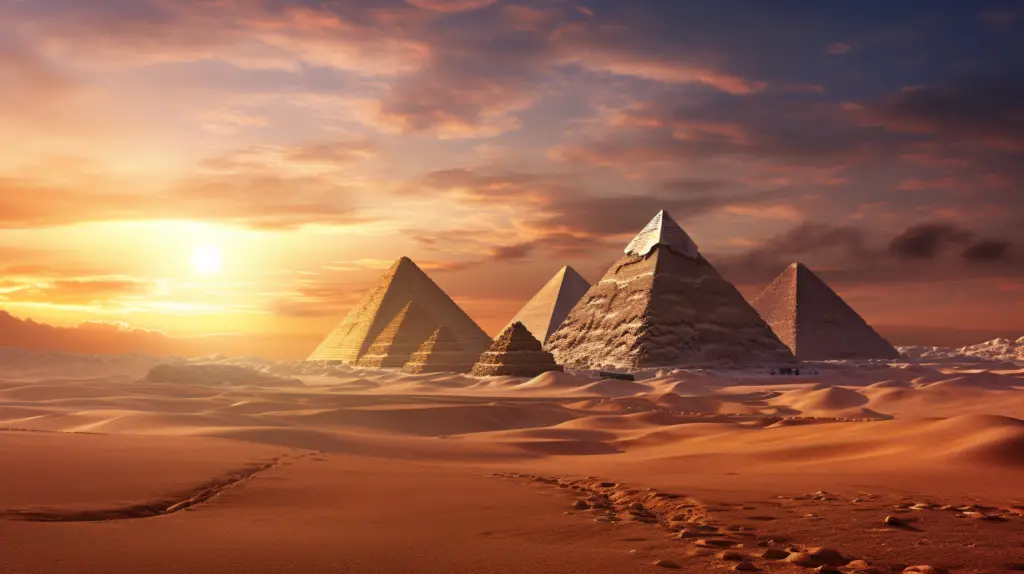The Egyptian pyramids, those astonishing testaments to a bygone era, continue to fascinate researchers, historians, and tourists alike. Rising from the sands of Egypt, these architectural marvels are remnants of an age where pharaohs ruled and gods walked amongst humans, at least in the collective imagination of the people. Their grandeur, the mystical stories they entail, and the brilliant craftsmanship they exemplify, hold the gaze of the world even millennia after their construction.

As you embark on this journey of discovery, here are 25 interesting facts about the Egyptian pyramids you may not have known.
1. The Great Pyramid is a Mathematical Marvel: The Great Pyramid of Giza, built for Pharaoh Khufu, stands at a height of around 481 feet, it was the tallest man-made structure for more than 3,800 years.
2. They Were Not Built By Slaves: Despite popular belief, the pyramids were not built by slaves. Archaeological evidence suggests that a workforce of thousands of skilled and unskilled laborers lived in good conditions and were likely paid for their work.
3. There are Over 100 Egyptian Pyramids: While the pyramids at Giza are the most famous, there are around 118-138 identified Egyptian pyramids. These were built over a period of 1000 years.
4. Pyramids were Built with Precision: The base of the Great Pyramid of Giza is horizontal and flat to within just 15 mm. The sides of the square are closely aligned to the four cardinal compass points to within four minutes of arc.
5. They Were Originally Encased in Limestone: The pyramids were once covered in polished white limestone, known as casing stones. Over the centuries, many of these stones were taken away for other construction projects.
6. The Pyramid of Djoser is the Oldest: Built during the 27th century BC for the burial of Pharaoh Djoser by his architect Imhotep, the step pyramid is considered to be the earliest colossal stone building and earliest large-scale cut-stone construction.
7. Purpose of the Pyramids: The primary purpose of the pyramids was to safeguard the pharaoh’s remains. This was essential for fulfilling their spiritual journey in the afterlife.
8. Internal Temperature Remains Constant: Despite the harsh desert temperatures, the interior temperature of the pyramids remains relatively constant, around 20 degrees Celsius.
9. The Bent Pyramid’s Unique Angle: The Bent Pyramid in Dahshur, built for Pharaoh Sneferu, is unique as it has two separate angles. This reflects a change in design midway through its construction, likely due to stability concerns.
10. A Boat Buried Beside the Great Pyramid: In 1954, a fully intact 4,500-year-old ship made from cedarwood was discovered in a pit next to the Great Pyramid. The Khufu ship is believed to be a “solar barge” used for the pharaoh’s heavenly journey.
READ MORE: 25 Interesting Facts About Dust Storms and Why They Happen
11. Aligned with the Stars: The three pyramids of Giza align with the constellation Orion’s Belt, and the pyramid’s air shafts are directed towards important star constellations.
12. Building Techniques Remain a Mystery: Despite various theories, the exact techniques used in pyramid construction remain a mystery. It’s estimated that around 2.3 million stone blocks were used in the Great Pyramid’s construction.
13. The Great Pyramid Was Only Dethroned in the 14th Century: It was the tallest structure in the world until 1311 AD when the central spire of the Lincoln Cathedral in England was completed.
14. A Pyramid Built by a Woman: The pyramid of Queen Hatshepsut at Giza is the earliest tomb known to have been built by a woman.
15. Earthquake-Resistant Design: The pyramids have a unique design with their cornerstones having ball and socket construction to deal with heat expansion and earthquakes.
16. The Great Pyramid is the Last of the Seven Wonders: Of the original Seven Wonders of the Ancient World, only the Great Pyramid remains largely intact.
17. Inscriptions Inside the Pyramids: Few pyramids contain inscriptions inside, with the Pyramid Texts, a collection of ancient Egyptian religious texts, first appearing in the Pyramid of Unas.
18. The Missing Capstone: The Great Pyramid was once topped by a capstone or pyramidion, possibly covered in gold. However, it is no longer present.
19. Incredible Structural Integrity: Despite thousands of years of erosion and even earthquakes, these pyramids stand tall, a testament to their incredible structural integrity.
20. Graffiti from the Past: Some pyramids bear graffiti from ancient workers, often seen as valuable historical records of the lives and language of the laborers.
READ MORE: 20 Amazing Facts About Black Cats: History, Myths, Superstitions
21. Pyramids Were Robbed in Ancient Times: Most pyramids were robbed of their valuable contents long ago, often within just a few centuries of their completion.
22. Pyramids Were More Than Tombs: They were part of a larger complex including temples and other structures to serve the deceased in the afterlife and honor the gods.
23. A Symbol of the Sun: The pyramid shape was symbolic of the slanting rays of the sun, and the Egyptians believed this shape helped the soul of the pharaoh ascend to the heavens.
24. Later Pyramids Were Smaller: After the reign of the Giza pyramid builders, later pharaohs chose to make smaller, less labor-intensive pyramids.
25. The Sphinx and the Pyramids: The Great Sphinx of Giza, a giant limestone statue with the body of a lion and the head of a man, is part of the same complex as the pyramids and is thought to guard them, though its original purpose remains debated.
READ MORE: 20 Interesting Facts About Mexico
The Egyptian pyramids have captured our collective imagination for thousands of years, not just for their scale and beauty, but also for the secrets they still keep. These 25 facts offer only a glimpse into the mystique and allure of these timeless structures. As we continue to delve deeper, we can only marvel at the ingenuity, faith, and ambition of the ancient Egyptians, leaving behind monuments that continue to captivate the world.


